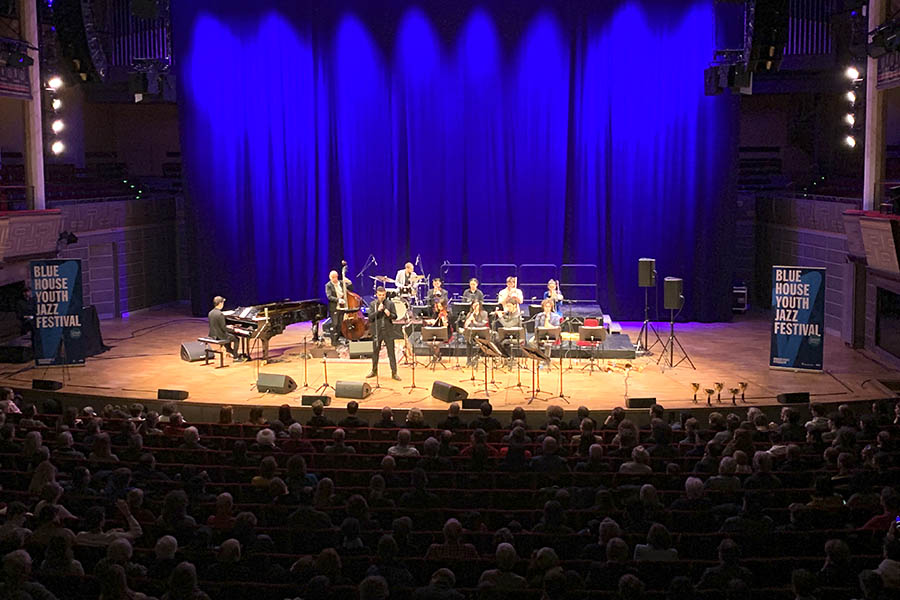Sant Andreu Reunion Jazz Band at the Blue House Youth Jazz Festival
Early this year (2023) I discovered that Joan Chamorro and the Sant Andreu Reunion Jazz Band from Barcelona would be guests of the annual Blue House Youth Jazz Festival in Stockholm, March 24-26. The festival welcomes 400 pupils/students and teachers for three intensive days of workshops, lectures and concerts. Invited professionals give the lectures, lead the workshops and perform. There is also a competition between the participating young jazz groups and another one between the participating young big bands.
Sant Andreu Reunion Jazz Band is a combination of members from different generations of the Sant Andreu Jazz Band, albeit not the youngest. Joan and the band’s role at the festival was to lead workshops, give concerts and in general to be a role model band for the young Swedish bands and their leaders. Maybe some of you, by this description of the festival, are reminded of Joan Chamorro’s own Jazzing Festival in Sant Andreu, Barcelona. But there were of course many differences and one significant difference is that Joan Chamorro would never organise a competition in music. (I will come back to this.)
Of course, my wife Margareta and I decided to attend the festival. Our aim was to enjoy the different parts of the festival, not least the closing concert by Joan Chamorro and the Sant Andreu Reunion Jazz Band, but also to study the methods of the workshops. We also agreed with Joan Chamorro to meet for an interview after the concert.
However, the arrangers made it clear that the only part of the festival open to the public was the last day’s competition and the closing concert by Joan and his band. (This restriction was another difference to the Jazzing Festival in Barcelona.) So, we attended part of the competition and the closing concert, and afterwards we met with Joan. To our great joy, band member Èlia Bastida also came along to meet us, and if needed to help with translations. The reunion band’s concert was only 45 minutes, but every minute was a joy! It was one of those occasions when you ask yourself if you have ever heard a Sant Andreu Band constellation sounding better. That may or may not be accurate, but was certainly how I felt. I was overwhelmed, not least by the vocals included in every piece.
Another café interview
After the concert, we went, along with Joan and Èlia, to the same café where I interviewed Joan, Èlia and Carla Motis almost five years ago. That interview resulted in the article The Sant Andreu Jazz Band formula and I wanted to follow up with Joan on parts of that interview, and bits from later articles. Our meeting became partly an interview, partly an enjoyable and interesting conversation.
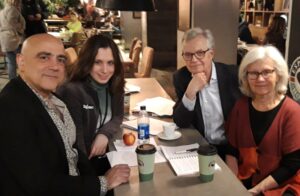
Joan, Èlia, Bengt-Ove and Margareta
The latest SAJB-related concert that Margareta and I attended, before this Stockholm concert, was the SAJB anniversary concert on December 10, 2021, in the Palau de la Música, Barcelona. That was a very special concert for the audience, not least because Joan Chamorro had managed to gather together almost all young musicians who have been members of the Sant Andreu Jazz Band during its first 15 years – some 70 musicians. Joan confirms that this anniversary concert was also a very special experience for the musicians on stage. It was an unusually big and difficult project to carry out, but it was very successful, and it was great to do this together with all former and current SAJB-musicians.
I ask Joan what the plans are for the reunion band, the Sant Andreu Reunion Jazz Band. “I start new projects every year”, says Joan, “and this band is one of my new projects”. As Joan puts it, he has started to “recycle” musicians. It is not far-fetched to believe that this new idea is the fruit of the ambition to gather musicians from different SAJB generations to celebrate the SAJB’s anniversary in 2021. (As he also did with the Joan Chamorro Presenta’s Big Band.)
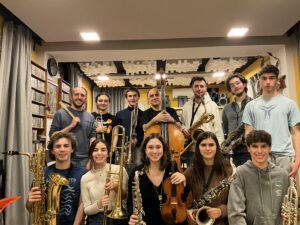
Sant Andreu Reunion Jazz Band
All members of this band are soloists and are good at improvising. Joan is also happy that several members also sing very well.
Every piece in the Stockholm performance included vocals with a lead singer and sometimes backup vocals. Joan earlier put together three projects profiling the vocal side of SAJB – La Màgia de la Veu 1, 2 and 3. Although this project has the same profile, Joan did not want to use that label again. The reunion aspect was instead highlighted. These are the members of the reunion band, the first six of which sing lead vocals.
- Èlia Bastida, violin, tenor sax, vocals
- Koldo Munné, alto & baritone sax, vocals
- Joan Martí, soprano & tenor sax, flute, vocals
- Clàudia Rostey, trombone, vocals
- Edu Ferrer, alto & baritone sax, vocals
- Perot Rigau, trombone, vocals
- Lola Peñaranda, tenor sax
- Elsa Armengou, trumpet
- Gerard Peñaranda, trumpet
- Pau Garcia, piano, sax
- Joan Chamorro, double bass, director
- Arnau Juliá, drums
The band has already played several concerts in various places, and I would not be surprised if it continues to play for quite some time – and maybe eventually develops into something else.
Sant Andreu Jazz Band
Our conversation then moved on to the current version of the Sant Andreu Jazz Band. Joan is amazed about how well everything works currently and feels that, overall, the performance of the Sant Andreu Jazz Band has improved. Many good musicians, who had reached a high level in the band, have left, but the band’s level is still rising meaning that the benchmark that the seniors set for the beginners to reach is also climbing. In particular, there are several good improvisers and vocalists in the band now.
Furthermore, Joan tells us that there are no problems at all with attitudes these days as has sometimes been the case in the past. All young players are happy and everyone is “on track”. Joan feels that the way the band now works is “like magic”; that the energy of the band is currently the best ever.
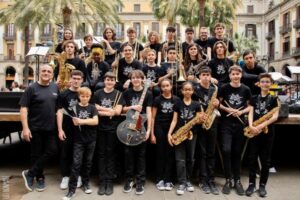
Sant Andreu Jazz Band of today
To me, this sounds as if Joan and the band are harvesting the fruits of all the work done over the years. Maybe the culture has even reached a state where it is self-reinforcing? As the band becomes increasingly well-known and acknowledged, this stronger “brand” of the band might strengthen the incentive for everyone to be part of the culture and contribute.
Values, behaviour and culture
So, what are the cultural traits that Joan has developed so well? In my interview five years ago, I asked about the basic concept of the Sant Andreu Jazz Band. Joan pointed out four principles, mainly cultural in character.
- Firstly, the young musicians need to hear a lot of jazz. Listening makes you feel the qualities and the soul of the music, and how it differs from other kinds of music. Of course, you have to learn the songs and to play your instrument, but hearing jazz played is more important than the command of transcriptions.
- Secondly, there is the belief that young people, children and teenagers, actually can play jazz. As a leader and teacher of young musicians you have to have that belief. The young musicians then feel your confidence in them, and they also feel their own confidence in themselves.
- Thirdly, there is the sense of presence. When you play you have to be there, not somewhere else. You have to be in the music and together with the others in the group. You must not observe yourself from the outside, from the views of spectators or a camera (whether or not they are present). Such a preoccupation would split your focus.
- Fourthly, there is the positive energy of the group. The younger learn from the older and you are perceived as important regardless of the size of your contribution. And eventually the younger become more experienced and take on the roles of seniors and role models. (Boström, Bengt-Ove: The Sant Andreu Jazz Band formula, 2018.)
I showed these quotes from my old article to Joan, and he felt that the principles remain the same. I also referred to Garry Berman’s interesting article from February 2022, where Joan talks about values and behaviour that are needed to make a group function.
I try to emphasize things like punctuality, effort, commitment, and other values that are important to me, such as gratitude, humility, generosity, sincerity, honesty, etc. Dedicating yourself to music is not just playing your instrument well. We are part of a community and for things to work, we have to be people, as far as possible, serious with our work and respectful in all aspects, with the rest of the musicians and of course, with the public that listen.” (Berman, Garry: Joan Chamorro and the SAJB: Past, Present, and Future, 2022.)
These are important values and behaviour that Joan Chamorro wants to promote when educating the band members, as Joan has put it, “both as musicians and as people”. The values and the behaviour form a positive band culture, but also individual qualities that members can possess through life.
Every band member has, of course, heard Joan talk about the importance of these values and the behaviour emanating from them. But as culture is such an important dimension of the quality of the Sant Andreu Jazz Band, I ask what Joan has done to promote and maintain a good culture.
There are two ways, says Joan. Firstly, I must lead by example. For example, as I require the members of a group to be on time, I should always be on time myself. And as I require humility, I must act with humility myself, etc. And secondly, if members do not respect the values of the culture, I must tell them to do so. On some occasions, it can be just by pointing out that a behaviour or an attitude is a deviation from what is expected. If someone shows a more general attitude problem over time, a longer conversation might be needed.
The two ways that Joan mentions are not new, or surprising, tools to educate young people, but of course, they need to be more than theory. They must be put into practice.
As a band leader Joan has a lot to teach other music leaders. When Joan gives lectures to teachers, he does not only speak about ways to teach music, he also talks about the importance of cultural aspects, such as the ones above. The musical and cultural aspects are important in themselves, but he believes that they also reinforce each other.
Comparisons and competition
I would argue that there is another trait of thought that can be seen as part of the culture that Joan wants to promote, and now we return to why Joan does not like music contests. In Garry Berman’s earlier mentioned article, Joan expresses this idea:
I like to think of music as something that isn’t a race to see who gets to the finish line first. It is a race without end, and during that journey, we musicians learn, improve, evolve, change, etc.” (Berman, Garry: Joan Chamorro and the SAJB: Past, Present, and Future, 2022.)
So, when I ask Joan about his views on the Blue House Youth Jazz Festival, he is very happy about the workshops and the concerts, and he expresses how nice it has been to meet all musicians, but then he ends by commenting on the festival contest between bands by stating that “you cannot compete in music”, a statement closely connected to his resistance to seeing music as a race between musicians.
But what about fans’ perspective, I ask Joan. I think it is clear from media posts that some fans have their favourites who receive more attention – typically girls rather than boys.
Fans might have favourites, but those are not my opinions, says Joan. “I never say that someone is my favourite. I treat everyone the same, young and old, boys and girls. Maybe singers have gained more attention from the fans, and more girls than boys used to sing in the band – but the trend now is that also boys come strong as singers.”
At this point Èlia had to leave us for a meeting, but Margareta and I continued our conversation with Joan for quite some time. Joan was very generous with his time this evening, but all good things sooner or later come to an end. We heartly thanked Joan for sharing the time with us at the café, and he left to join the band members.
When you have had a discussion with Joan, you tend to continue to think about the subjects afterwards. This occasion was no exception. Together with Margareta, I continued to reflect on the values and the culture that Joan wants to promote, and which he has so successfully developed in the SAJB.
Reflections
What I was contemplating, and still am, is what these values and this culture mean to us, the fans of Joan Chamorro and the SAJB.
Of course, we can enjoy the result of the values and culture in terms of magnificent music, and we can also enjoy and praise what we apprehend of the culture as such. But what do the values mean to our fan approach to the SAJB? What would happen if we embraced the values to the extent that we used them as guidelines for our own approach and behaviour towards the SAJB and its members? Can we, by adopting these values, even help Joan in developing the SAJB?
Let’s start with Joan’s statements about musical contests. Of course, one can see that different musicians have reached different levels in their development but comparing individual musicians with themselves might be of more interest; to see and appreciate the development of each individual. This is a natural view for a person who in practice educates young people, like Joan does, but it might also be a view of more general relevance for music life.
Adding to this philosophical view on competition there is also the problem of measuring quality. Competition rests on the idea that you can compare performances with some degree of objectivity, but there is always a measure of subjectivity involved in rating individual performances.
The non-competition value is closely related to the value that all SAJB musicians are perceived as important in the band, regardless of the size of their contribution. Together these two values form a culture where mutual appraisal and encouragement are more important than competition as driving forces of development. Of course, you never know what goes on in people’s minds, but I believe that the musicians’ behaviour towards each other on stage supports the case that these positive values are strong within the SAJB.
Equality
The value that each band member is important regardless of contribution has implications for equality. Joan treats everyone equally, but do we as fans always act like that? As I note above, often the girls, who have frequently been the vocalists, have appeared to garner the greater attention from fans in media posts. I think that fans who want to act in harmony with SAJB values, should embrace the same equality ethos as does the band.
This ethos is valid not only on the group level (boys and girls) but also on the individual level, meaning that everyone should get the same level of attention. Of course, I do not believe that this “ideal” is practically possible, and one cannot deny fans to have favourites. But it is one thing for fans to appreciate some individual musicians more than others, and quite another thing to proclaim, or in other ways make it obvious on social media, who their favourites are, I would argue.
Joan points out that the number of boys who are very good vocalists has increased, so, if the level of attention paid is dependent on the strength of vocalists’ performances, the difference in attention paid between the boys and girls will diminish or even disappear. If such disparities in the level of attention persist, the explanation for them lies elsewhere. Maybe we after all do not pay more attention to the voice as an instrument of expression than to other instruments of expression? But if we do, why is it right to do so?
All in all, my belief is that Joan and the SAJB would benefit from a more evenly spread attention from its fans.
Presence
One important principle that Joan has tried to implement in the band (I believe successfully) is the importance of presence, not thinking about yourself from the outside. The young musicians very much behave as serious musicians on stage. They concentrate, sometimes closing their eyes to get deeper into the music, and seldom smile – just like many professionals. I have read a few comments on social media in which fans complain about the serious expression of SAJB musicians, probably expecting these young adults to appear to be having more fun. But why? Joan trains them to be serious about their music, which often leads to intense concentration and a measure of inwardness.
The reason he wants the young musicians to refrain from imagining themselves from the outside (like the object of a camera) is that such a preoccupation would disturb their concentration on being in the music together with their fellow band members. Therefore, we should not demand any other behaviour from the young musicians than that which comes naturally to them when concentrating on the music – like we do with all professional jazz musicians.
As a matter of fact, any comment from fans on looks is irrelevant to the musical professionalism and quality that Joan wants to promote with the students – and such comments can disturb the students’ concentration on being in the music. Therefore, I believe that we, by refraining from comments on looks, help Joan with the SAJB project.
A musical garden
Joan Chamorro’s many different music projects are like parts of a ‘musical garden’ where a lot of different ‘garden arrangements’ are created and nurtured. They continue to develop or give way to new projects – and maybe they return later. The garden develops all the time.
The different projects, in one way or another, all emanate from Joan and his base project, the Sant Andreu Jazz Band. But, although Joan is behind all the projects, he tries to give room for the different wishes and profiles of the musicians involved. And of course, he develops individuals as well as the groups, often by giving them challenging musical tasks and by paying attention to the cultural aspects of the band.
Along the way, the seniors might be involved in co-leading projects, thereby getting ready for the day when they start their own careers outside the SAJB. But ‘outside’ might be a tricky condition to determine. Musical networks are by nature not strictly defined. For instance, in the Meraki project of Èlia Bastida and Carolina Alabau, we find Joan Chamorro himself and some other musicians accompanying Èlia and Carolina in some of the songs.
One of the early SAJB members who is now a member of the Reunion band is Edu Ferrer; he is one of several prominent singers, a talent he showed early on as a young SAJB musician. Edu likes to sing songs from the Sinatra songbook, and he received several opportunities to do so in the Stockholm concert. Edu is also part of the project Joan Chamorro trio & Edu Ferrer tribute to Frank Sinatra.
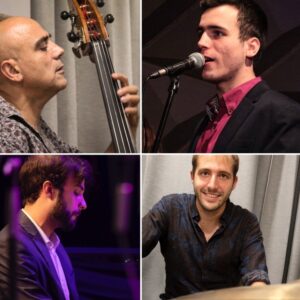
Joan Chamorro trio & Edu Ferrer tribute to Frank Sinatra
The SAJB alumni Edu Ferrer and the Sinatra project is only one of many project examples. Below, you can find all ongoing projects along with their different members with different musicians frequently appearing in different contexts.
It is natural that members of the SAJB spin-off projects are experienced, but there are exceptions. In the project the Sant Andreu Dixieland Band, Joan Chamorro has assembled the youngest members of the current Sant Andreu Jazz band. The Joan Chamorro ‘garden of music‘ grows, evolves and flourishes! And as many SAJB fans know, even outside Joan’s ‘musical garden’ there are many projects grown from SAJB seeds.
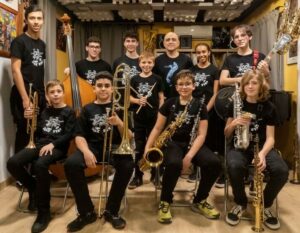
Sant Andreu Dixieland Band
Joan Chamorro’s current projects
The Sant Andreu Jazz Band
- Sander Theuns, alto & soprano sax
- Pere Company, tenor sax, clarinet, and vocals
- Shanti Ming, alto sax
- Koldo Munné, alto & baritone saxes, vocals
- Lola Peñaranda, tenor sax and clarinet
- Andreu Romero, tenor & baritone sax
- Noa Abike Bazuaye, alto sax
- Bernat Benavente, alto sax
- Martí Costalago, trumpet
- Max Munné, trumpet
- Gerard Peñaranda, trumpet
- Elsa Armengou, trumpet
- Martha Vives, trumpet
- Luc Martín, trombone
- Perot Rigau, trombone, vocals
- Claudia Rostey, trombone, vocals
- Hugo Vlach, trombone
- Anna Ndiaye, piano, vocals
- Pau García, piano
- Nils Theuns, drums
- Blai Forns, drums
- Didac Moya, drums
- Jordi Herrera, double bass
- Mateu Teixidó, double bass
Sant Andreu Reunion Band
- Èlia Bastida, violin, tenor sax, vocals
- Koldo Munné, alto & baritone sax, vocals
- Joan Martí, soprano & tenor sax, flute, vocals
- Clàudia Rostey, trombone, vocals
- Edu Ferrer, alto & baritone sax, vocals
- Perot Rigau, trombone, vocals
- Lola Peñaranda, tenor sax
- Elsa Armengou, trumpet
- Gerard Peñaranda, trumpet
- Pau Garcia, piano, sax
- Joan Chamorro, double bass, director
- Arnau Juliá, drums
Sant Andreu Dixieland Band
- Martí Costalago, trumpet
- Sander Theuns, soprano & alto sax
- Pere Company, tenor sax, clarinet, vocals
- Luc Martin, trombone
- Anna Ndyae, Pau Garcia, piano
- Jordi Herrera, double bass
- Nils Theuns, drums
Joan Chamorro trio & Èlia Bastida & Koldo Munné
- Joan Chamorro, double bass
- Josep Traver, guitar
- Arnau Julià, drums
- Èlia Bastida, tenor sax, violin, vocals
- Koldo Munné, alto sax, vocals
Brazilian Quintet
- Joan Chamorro, double bass
- Josep Traver, guitar
- Arnau Julià, drums
- Èlia Bastida, violin, tenor sax, vocals
- Koldo Munné, alto sax, vocals
Joan Chamorro Big Four
- Joan Chamorro, double bass
- Josep Traver, guitar
- Èlia Bastida, violin, tenor sax, vocals
- Koldo Munné, alto sax, vocals
Joan Chamorro trio & Edu Ferrer tribute to Frank Sinatra
- Edu Ferrer, vocals
- Joan Chamorro, double bass
- Marc Martín, piano
- Arnau Julía, drums
